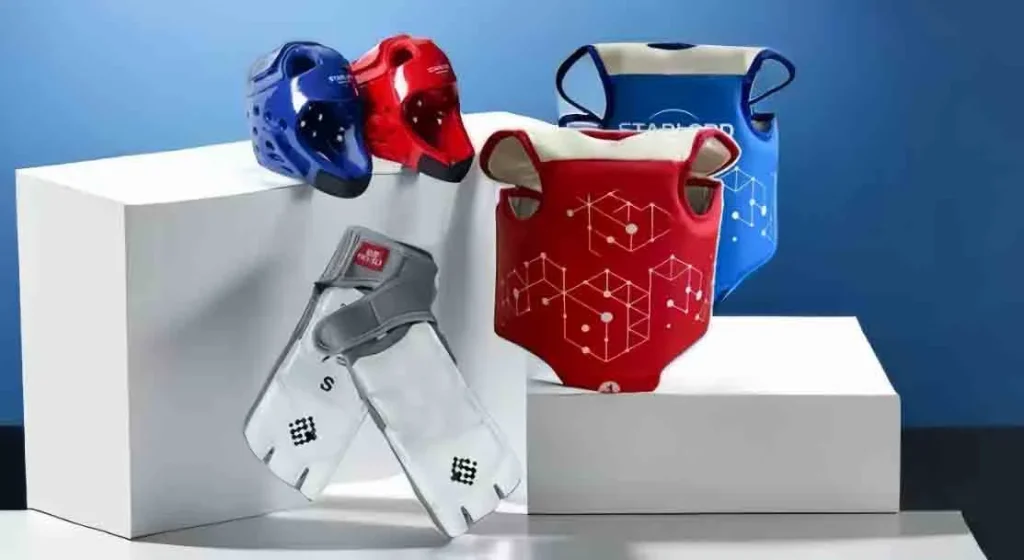Summary:
This guide will help you choose and buy Taekwondo electronic protective gear. Whether you are a beginner or an experienced coach, you’ll find clear explanations about what electronic gear is, the types commonly used in training and competitions, the differences between systems, and the key features to consider when making a purchase.
Taekwondo Protection Scoring System (PSS)
Taekwondo electronic protective gear Protection Scoring System (PSS)integrates advanced sensor technology into items like vests, headgear, and other components used in training and competitions. These systems detect impacts, calculate scoring data, and ensure fair play, while also helping prevent injuries during high-speed sparring. By converting physical strikes into digital signals, this equipment plays a crucial role in modern Taekwondo events.
In training, it helps athletes identify areas for improvement, while in competitions, it offers a more efficient, accurate, and fair way to score matches, minimizing human error.
Currently, two major types of electronic gear are available: KPNP-style and Daedo-style.
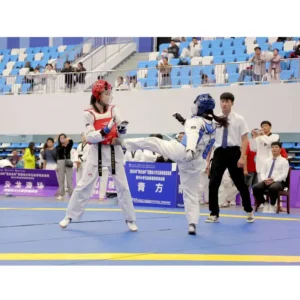
What’s the Difference? KPNP and Daedo
KPNP-Style Systems:
These systems are known for their innovative sensor arrays, capable of accurately recording the intensity and location of impacts. The sensors are embedded in the padding to provide precise scoring data, primarily focusing on detecting the hits on the player’s body.
| Chest Guard | Head Guard | Socks |
|---|---|---|
| 1# (110-140cm) | S (110-140) | xs (29-32) |
| 2# (140-150cm) | m (150-170) | s (33-35) |
| 3# (160-170cm) | L (180-190CM) | M (36-38) |
| 4# (180-190cm) | L (29-41) | |
| XL (42-43) | ||
| XXL (44-45) |
Daedo-Style Systems:
Daedo systems focus on reliability and ease of use, making them widely adopted by training centers and event organizers. Their technology is more widely applied, especially for large-scale events, offering a higher number of sensors with increased sensitivity. These systems are known for their durable design and consistent performance across different conditions.
Both systems emphasize fast response times, high sensitivity, and seamless integration with scoring software. Understanding the differences between these two systems will help you decide which one best suits your training or competition needs.
Quote: “Choosing the right electronic protective gear means balancing accuracy, durability, and user-friendliness. Both KPNP and Daedo systems deliver excellent performance, but the final decision should meet your specific requirements.”
| Chest Guard | Weight (KG) | Foot Guard | Size | Head Size | Age Group |
|---|---|---|---|---|---|
| 0# | 15-25 KG | XS | 36-37 | S | 4-8 years |
| 1# | 25-40 KG | S | 38 | M | 8-15 years |
| 2# | 40-55 KG | M | 39-40 | L | 15-18 years |
| 3# | 55-70 KG | L | 41 | XL | 18+ years |
| 4# | 70-80 KG | XL | 42-43 | ||
| 5# | 80+ KG | XXL | 44 | ||
| XXXL | 45-46 |
Key Features to Consider When Buying Electronic Protective Gear
Before purchasing, consider several key features that influence performance, durability, and ease of use. Your choice will depend on whether you’re buying for training or competition, your budget, and your long-term support needs.
Basic Features
Sensor Accuracy:
Look for gear that accurately records impacts. Precision is essential for fair scoring in matches.
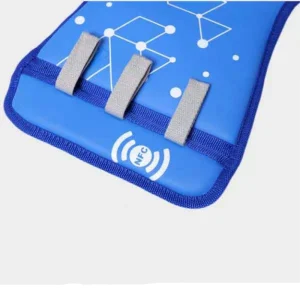
Material Durability:
The protective gear should be made of high-quality materials that are resistant to wear, moisture, and impacts. Common materials include polyethylene foam and reinforced vinyl.
Battery Life and Power Management:
Reliable battery life ensures that the system remains functional during long training sessions or competitions.
Ease of Calibration and Setup:
A simple setup process minimizes downtime and makes routine checks and recalibrations easier.
Customization Options:
Many systems offer customization for logos, colors, and sensor configurations. This is particularly useful for clubs and academies wishing to maintain consistent branding.
Connectivity and Data Management:
Ensure the system can easily connect to scoring software and other digital platforms to provide real-time data and analytics.
Other Considerations
Warranty and Support:
Check the warranty period and available after-sales support. A strong warranty and dependable customer service can make a big difference if issues arise.
Regulatory Compliance:
Verify that the product meets relevant competition standards and safety regulations.
User Feedback:
Review testimonials and case studies from other users. Real-world performance often reveals strengths and weaknesses that technical specifications alone may not show.
Feature Comparison Table
| Feature | Deado KPNP–Style System | Daedo–Style System |
| Sensor Precision | High accuracy for pinpoint scoring | Consistent performance in various environments |
| Durability | Reinforced sensor integration | Robust build with easy recalibration |
| Battery Performance | Long-lasting with optimized power management | Reliable battery life for extended sessions |
| Customization Options | Full digital customization available | Flexible design options with standard templates |
| Ease of Setup | Requires professional installation | User-friendly interface for quick setup |
| After-Sales Support | Comprehensive technical support | Extensive training and customer service |
Step-by-Step Buying Process
Assess Your Needs:
Determine whether you need the gear for training, competition, or both.
Research and Compare Products:
Compare the two systems offered: one is similar to Daedo, and the other mimics KPNP.
What’s Included in the Set?
- Protective gear set: Includes two headgear, two chest protectors, two pairs of foot protectors, sensors, transmitters, receivers, chargers, and software.
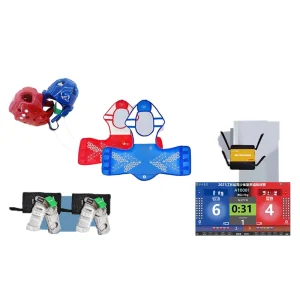
Product Sizing:
Consider the size options based on your venue and athlete requirements. Ensure the proper number of chest, head, and foot protectors are selected. Typically, each athlete purchases their own foot protectors.
Custom Branding Options:
If desired, you can customize the gear with your logo and color choices.
Check Warranty Terms:
The gear typically comes with a one-year warranty for protection against defects.
Installation and Setup:
After purchasing the software, contact us to get the system. You will receive free software updates whenever new versions are released.
Collaboration for Installation:
Work with the manufacturer’s technical team for proper installation. Follow the calibration instructions provided in the manual.
Testing:
Perform initial tests to ensure the sensors and digital interfaces are functioning correctly.
Training and Maintenance:
- Schedule training sessions for staff and athletes on how to use and maintain the gear.
- Keep a maintenance log for routine inspections and recalibrations.
- Utilize technical support if issues arise during initial use.
Other Products You May Need:
Training Mats:
Useful for sparring and competitions roll mats and eva mats.
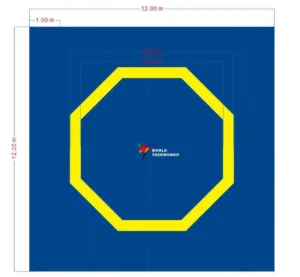
Taekwondo Uniform (Dobok):
Necessary for training and official events.
Taekwondo Shoes:
Essential for practice.
Protective Gear Bag:
Helps store and organize your gear.
Other Taekwondo Equipment:
Additional items such as paddles, boards, and mats can enhance your training.
Frequently Asked Questions (FAQ)
What types of Taekwondo electronic protective gear are available?
There are two main types: one follows the KPNP-style sensor system, and the other mimics Daedo. Both types are designed to accurately capture impact data and provide precise scoring.
How do I determine which system is right for my facility?
Evaluate your training needs, competition level, and budget. Consider factors like sensor accuracy, durability, ease of calibration, and customization options. Consulting with a technical expert or requesting a demo can help you make a smart choice.
What does the installation process involve?
The installation involves securely mounting the gear, connecting it to power and data interfaces, and performing detailed calibration. You’ll receive user manuals and technical support to guide you through every step.
How long does the calibration process take?
Calibration usually takes between 15 to 30 minutes per unit, depending on the complexity of the setup and environmental factors. Proper calibration is crucial for accurate scoring.
What should I do if I experience issues with the sensors?
Contact the manufacturer’s customer service for troubleshooting. Regular maintenance, including recalibration and checks, helps prevent common problems.
Is there training available for using and maintaining the gear?
Yes, many manufacturers offer both on-site and online training. Detailed manuals and support documents will help your staff and athletes get familiar with the system.
Final Key Takeaways
Assess Your Needs:
Determine whether you need the gear for training, competition, or both, and assess the required accuracy and durability.
Understand the Technology:
Know the differences between the KPNP-style and Daedo-style systems to choose the right fit for your needs.
Follow a Structured Purchasing Process:
From research to consultation and installation, a step-by-step approach will ensure a smooth buying experience.
Check Quality and Support:
Prioritize products with consistent sensor performance, solid build quality, and strong after-sales support.
Plan for Maintenance:
Regularly inspect, clean, and calibrate your electronic protective gear to maintain peak performance.
This guide provides a clear, actionable framework for selecting the best Taekwondo electronic protective gear based on your needs. By carefully evaluating the system types, features, and installation procedures, you’ll ensure that your investment enhances both safety and performance in your training and competitions.
If you have further questions or need personalized advice, feel free to contact our sales team. We’re here to offer detailed information, technical support, and a smooth purchasing experience.
With this guide, you are well-prepared to make an informed decision and enjoy the benefits of cutting-edge electronic protective gear, ensuring higher safety, accuracy, and performance during your Taekwondo practices and competitions.

